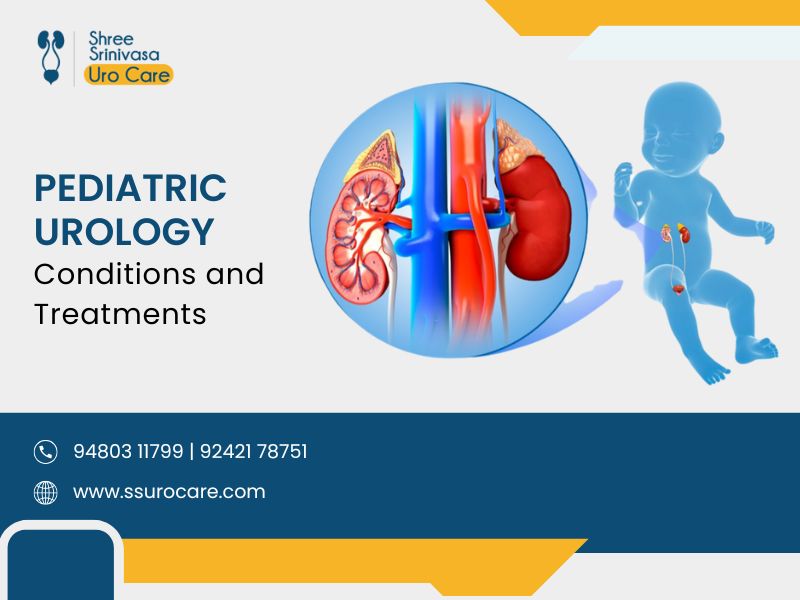Pediatric urology focuses on the urinary system—like the kidneys and bladder—in children. Many of these conditions can even be spotted before birth during ultrasound scans. While these issues affect both boys and girls, the good news is that with proper care, most can be treated effectively!
Common Pediatric Urology Conditions
Here are some of the most common pediatric urology conditions you might come across:
- Antenatal Hydronephrosis: This occurs when fluid builds up in the kidney, making it enlarged before birth. It can often be detected through fetal ultrasounds.
- Bedwetting (Nocturnal Enuresis): Bedwetting is mostly seen in boys, though girls can experience it too. In some cases, kids might also struggle with daytime wetting. Bedwetting can sometimes be linked to urinary tract infections (UTIs), so it's worth keeping an eye on.
- Hernia: This happens when part of a tissue or organ pushes through a weak spot in the body. It's pretty common and can be easily addressed.
- Hydrocele: This is when fluid builds up in the scrotal sac, often seen in newborns, and usually resolves on its own.
- Hypospadias: A birth defect where the opening of the urethra is on the underside of the penis rather than at the tip. It’s typically noticed in infancy and is treatable.
- Neurogenic Bladder: This condition happens when nerves don’t communicate properly with the bladder, leading to urinary issues. It can cause incontinence, but therapy and treatments can help.
- Spina Bifida: A condition where the spinal cord doesn’t form correctly during development. It can also impact the bladder.
- Undescended Testes: This occurs when one or both testicles don’t drop into the scrotal sac as they should during fetal development. Most of the time, this clears up naturally in the first year.
- Ureteropelvic Junction Obstruction: A blockage in the area where the ureter connects to the kidney, causing issues with urine flow.
- Vesicoureteral Reflux (VUR): This is when urine flows backward from the bladder to the kidneys, which can be spotted through prenatal ultrasounds or after a UTI.
- Tumors: Tumors affecting the kidneys or bladder in children, though rare, can occur and require careful medical attention.
Treatment for Pediatric Urology Conditions
When it comes to treating these conditions, the approach is typically a combination of non-invasive, minimally invasive, and sometimes reconstructive surgery. Let’s break these down:
Non-Invasive Treatments
These treatments focus on less invasive approaches and are often used to manage symptoms or diagnose conditions. Some options include:
- Biofeedback: A cool mind-body therapy that helps teach muscle control for better bladder function.
- Pelvic Floor Training: Particularly helpful for kids with neurogenic bladder issues.
- Medications & Nutritional Counseling: Depending on the condition, these can help improve bladder function and overall health.
- Ultrasound Imaging: Used for diagnosing fetal urology conditions during pregnancy.
Minimally Invasive Treatments
Thanks to robotic surgery and modern technology, pediatric urological treatments are now quicker and less invasive. These methods involve smaller cuts, less risk, and faster recovery. Some of these treatments include:
- Bladder Augmentation & Mitrofanoff Procedure: Helps with neurogenic bladder by improving bladder capacity.
- Pyeloplasty: A surgery to treat ureteropelvic junction obstruction.
- Ureteral Reimplantation: This is done to fix vesicoureteral reflux and prevent urine from flowing backward.
Reconstructive Surgery Treatments
For certain more complex conditions, surgery is needed. These surgeries help restore proper function to the bladder, genitals, or urinary system. Some common procedures include:
- Bladder Outlet Surgery: This includes bladder neck reconstruction and sling placement to treat neurogenic bladder.
- Complete Primary Repair: Used to fix bladder exstrophy, a condition where the bladder is outside the body.
- Genital Reconstruction: Helps with Congenital Adrenal Hyperplasia (CAH) to ensure proper genital function.
- Hypospadias Repair: Corrects the position of the urethral opening to ensure a normal urinary stream.
The Takeaway
While pediatric urology conditions may sound complicated, early detection and treatment can make all the difference. Whether it's a minor issue or something that needs surgery, there are many ways to treat and manage these conditions so your child can live a happy, healthy life.
Don’t hesitate to reach out to us at Shree Srinivasa Uro Care if you need urology treatment for kids in Bangalore. We’ll guide you through the process and help you make the best health decisions for your little one!

